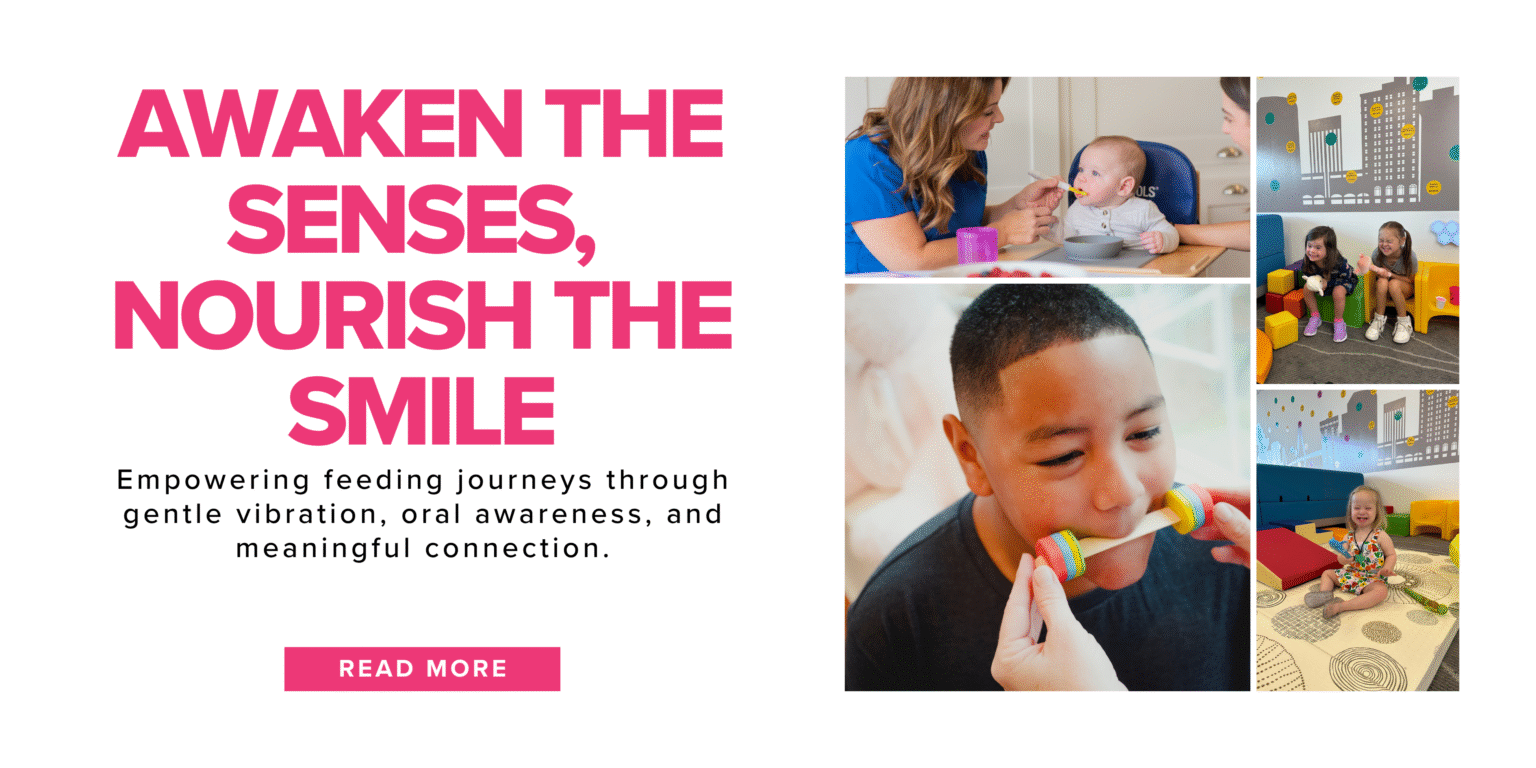By: Robyn Merkel-Walsh MA, CCC-SLP
Presentation of the Problem:
Individuals with Down syndrome are at risk for what is known as Orofacial Myofunctional Disorders or OMD. OMD can impact the oral phase of feeding, oral resting postures and oral placement skills for speech clarity. OMD issues require tactile therapies which include Myofunctional and Oral Placement Therapy (OPT). Myofunctional therapy and OPT are not the same as non-speech oral motor exercises. The purpose of this article is to differentiate the difference between non-speech movements and speech–like movements in treatment for individuals with Down syndrome, and to explore various types of tactile therapies that may help facilitate progress.
What Kind of Therapy Are We Talking About and Is It Evidenced Based?:
The ongoing question in the field of speech pathology is whether or not Oral Motor Therapy is evidenced based. Evidence Based Practice (EBP) according to the American Speech and Hearing Association is “the integration of best research evidence with clinical expertise and patient values” (ASHA, 2005). There is a misconception that EBP is limited to double-blind studies when in fact EBP is very centered on valuing feedback from the individual receiving treatment, and the clinical data collected in therapy. Not every method in the field of speech pathology has a large sampled, double blind study. For example, there is no proof that mirror aides in articulation therapy, but many therapists and patients report the value of mirror use when learning to imitate speech sounds. In addition, no one study can prove that another study is not valuable. No one study has proven that oral-motor, OPT or Myofunctional therapy is an invalid or unethical therapy method.
Another problem is that Oral Motor Therapy is a very general term that leads to confusion. Pre-feeding exercises, non-speech oral motor exercises, myofunctional therapy, strengthening exercises, swallowing exercises, oral imitation tasks and the use of oral speech tools were all being associated with the term Oral Motor Therapy. Though many therapists and parents see the clinical success of these therapies, there is still controversy in the field about the efficacy of these therapies. This is why in 2010 Diane Bahr and Sara Rosenfeld-Johnson wrote a landmark article in Communications Quarterly, outlining the difference between non-speech oral motor exercises (NSOME) and OPT. The major difference noted, was that NSOME are movements which are not related to speech sounds, while OPT therapy only includes speech-like movements (Bahr & Rosenfeld-Johnson, 2010). OPT follows the principles of Van Riper’s Phonetic Placement Therapy (PPT), and uses tactile cueing to help individuals who cannot respond to visual-verbal treatment cues (Marshalla, 2008). The use of therapy tools in speech pathology is certainly not new according to Pam Marshalla (2012) , and therapists admit that even after hearing that oral-motor exercises may not have research to support their use, they still use them in practice (Bahr, 2011).
Over thirty-five years ago, The International Association of Orofacial Myology (IAOM) was formed, and has addressed the need for regulated educational opportunities and standardized college level credentialing of therapists to treat OMD (Snow, 2015). Experts in myofunctional therapy understand the connection between the airway, dentition, and tongue posture, swallowing and speech clarity. The Myofunctional Clinic of Bellevue has compiled an excellent list of EBP to support the use of myofunctional therapy with a variety of individuals (Bellevue, 2015). Gommerman & Hodge produced a study analyzing the effectiveness of myofunctional therapy and sibilant production and found that articulation therapy was achievable in only four therapy sessions after a tongue-thrust disorder was remediated in myofunctional therapy (Gommerman & Hodge, 1995).
Oral-motor therapy has never been debated in cases of oral phase dysphagia or for tongue-thrust disorders; therefore it seems questionable that some experts in the field continuously debate the ethics and efficacy of these practices, especially in the Down syndrome populations, where we can predict issues with OMD. For example, Caroline Bowen has a publication on her website indicating that NSOME are unnecessary for children with Down syndrome (Bowen, 2015). The rationale is that to gain speech, speech must be worked on. There is some misconception that speech-language pathologists (SLPs) who work on OMD issues are not working on speech, and this is not the case (Merkel-Walsh & Bahr, 2014).
The Importance Of Treating Orofacial Myofunctional Disorders in Down Syndrome:
When a baby is born with Down syndrome, there are some factors we assume to be true about craniofacial development, feeding and swallowing. In 1997, Sara Rosenfeld-Johnson identified the myths of Down syndrome. This included: a high narrow palatal vault, (Myth #1), tongue protrusion (#2), mild to moderate conductive hearing loss (#3), chronic upper respiratory infections (#4), mouth breathing (#5), habitual open mouth posture (#6), and finally, the impression that the child’s tongue is too big for its mouth (#7) (Rosenfeld-Johnson, 1997). The reason Sara referred to these issues as myths, is because clinical evidence suggests that these issues can be prevented and/or improved by therapeutic intervention. For example, Sara Rosenfeld-Johnson presented case studies at the American Speech and Hearing Association annual convention, highlighting improvements in an adult patient with Down syndrome with one month of OPT (Rosenfeld-Johnson, 2014).
Despite the myths, clinicians are often faced with a variety of orofacial myofunctional challenges when treating individuals with Down syndrome. This includes but is not limited to: poor speech intelligibility, tongue thrusting, bruxing / teeth grinding, oral-phase feeding deficits and inappropriate oral habits (Bahr , 2001). It is important to treat these issues in conjunction with language-based speech therapy.
Since there is some confusion regarding terminology, it is important to understand various types of OMD therapies. We can categorize therapeutic interventions into four categories:
- Pre-feeding/Oral Sensory-Motor Therapy: These are exercises introduced to improve jaw, lip, and tongue movements as a prerequisite for safe, effective nutritive feedings. A pre-feeding plan is always one step ahead of a feeding plan. For example, if the goal is spoon feeding, the infant is receiving the primary source of nutrition from the breast and/or bottle, while the therapist works on the sensory-motor skills needed for spoon feeding (Overland & Merkel-Walsh, 2013). It is important to understand the oral-motor developmental hierarchy and age related normative data when designing a pre-feeding treatment plan.
- Feeding Therapy : Therapeutic feeding may focus on the oral phase of feeding, and/or the pharyngeal phase of feeding. Feeding therapy involves manipulation of the placement of food in the mouth, designing the tastes, temperatures and tastes to work with, and is always considerate of safety. Feeding therapy often involves the choice of therapeutic feeding equipment, including adaptive seating, as well as therapeutic spoons, cups, forks, and straws (Overland & Merkel-Walsh, 2013).
- Oral Placement Therapy: OPT does not include NSOME. OPT is a specific therapy which involves tactile cueing in order to facilitate the articulatory postures required for precise speech sound production. OPT follows the principles of Van Riper’s Phonetic Placement Therapy in which: a therapist facilitates an oral posture with a therapy tool, drills this posture through repetition, and slowly fades out the tactile cue once the individual can produce the sound accurately (Bahr D. & Rosenfeld-Johnson, 2010).
- Myofunctional Therapy: Joy Moeller, a dental hygenist who specializes in myofunctional disorders, defines this therapy as a program used to correct the improper function of the tongue and facial muscles used at rest, for chewing and for swallowing (Moeller, 2008). Myofunctional therapy is essentially a combination of pre-feeding, feeding, and OPT. Dentists, lactation consultants, otolaryngologists, dental hygienists and SLPs treat myofunctional disorders. Myofunctional therapy often involves a hierarchy of exercises, which helps an individual simultaneously correct oral-rest posture, oral habits (e.g. thumb sucking) swallowing and speech sound production (Merkel, 2002).
Individuals with Down syndrome often may require all four types of tactile therapies, since they may often present with feeding and speech issues. The problem remains, that many universities are not teaching these methods to clinicians, and families are struggling to find the services (Pierce & Taylor, 2002). In order to understand how these therapies can facilitate improvement, let’s look at some orofacial myofunctional issues associated with Down syndrome:
| PROBLEM | Activity | Tactile Intervention |
| Low jaw posture and tongue protrusion during oral rest posture | Therapist can work on facilitation of lip closure by placing a Jiggler tool in between the lips to facilitate lip closure. (Overland & Merkel-Walsh, 2013).
|
Pre-feeding |
| Reversed swallowing pattern/tongue thrust | Therapist engages client in therapeutic straw drinking to facilitate jaw stability, lip rounding and tongue retraction. (Rosenfeld-Johnson S. 2009).
|
Feeding Myofunctional |
| Teeth grinding | Therapist uses appropriate biting activities, chewing, appropriate mouthing activities, and massage techniques (Bahr, 2001). Therapist implements a gum chewing program to facilitate an appropriate replacement for teeth grinding (Rosenfeld-Johnson, 2009).
|
Pre-feeding Feeding Myofunctional |
| Interdental lisp | Therapist implements activities to superimpose lip closure with tongue retraction in order to improve strength and dissociation of the musculature, such as therapeutic horn and bubble blowing (Rosenfeld-Johnson, 2009; Merkel, 2002). The tools will be faded when the oral placement skill is achieved and the individual can produce the target sound without the use of the tactile cue/tool.
|
OPT Myofunctional |
Conclusions:
Individuals with Down syndrome may present with orofacial myofunctional challenges. While some therapists argue that non-speech oral motor exercises are not appropriate for these individuals, experts in tactile therapies have worked diligently to differentiate NSOME from OPT. Evidenced Based Practice is not limited to double blind studies and includes client feedback and therapeutic outcomes. Experts in OMD have provided evidence over the years to support the use of tactile therapies, and the relationship between swallowing and speech. Practicing clinicians are providing more case studies in the research base and most importantly, individuals who have engaged in OPT have positive reports of progress. There is no doubt that more studies need to be performed, and experts in OPT are hopeful to have more support from universities to perform larger group studies.
 Robyn Merkel-Walsh MA, CCC-SLP is a speech-language pathologist with over 20 years’ experience devoted to oral motor, feeding and OPT. She works full time for the Ridgefield Board of Education, in addition to her private practice and affiliation as a lecturer for TalkTools®. Robyn is the Acting Chair of the Oral Motor Institute and has recently presented a poster session at the ASHA convention. You may contact Robyn at robynslp95@aol.com.
Robyn Merkel-Walsh MA, CCC-SLP is a speech-language pathologist with over 20 years’ experience devoted to oral motor, feeding and OPT. She works full time for the Ridgefield Board of Education, in addition to her private practice and affiliation as a lecturer for TalkTools®. Robyn is the Acting Chair of the Oral Motor Institute and has recently presented a poster session at the ASHA convention. You may contact Robyn at robynslp95@aol.com.
Bibliography
ASHA (2005). Evidence-based practice in communication disorders [Position Statement]. Retrieved from asha.org: http://www.asha.org/policy/PS2005-00221/
Bahr, D. & Rosenfeld-Johnson (2010). Treatment of Children With Speech Oral Placement Disorders (OPDs): A Paradigm Emerges. Communications Quarterly, vol. 31 no. 3 131-138 .
Bahr, D. (2001). Nobody Evert Told Me (or my mother) That ! Arlington, TX: Sensory World.
Bahr, D. (2011, September). The Oral Motor Institute. Retrieved from The Oral-Motor Debate Part I: Understanding the Problem: www.oralmotorinstitute.org/mons/v3n1_bahr.html
Bellevue, M. C. (2015, March ). Studies showing efficacy of orofacial myofunctional therapy. Retrieved from Myofunctional Clinic of Bellvue: http://myofunctional.com/internal/resources.html
Bowen, C. (2015, January 13). Controversial Practices in Children’s Speech Sound Disorders – Oral Motor Exercises, Dietary Supplements, Auditory Integration Training . Retrieved from Speech-Language Therapy.com: http://www.speech-language-therapy.com/index.php?option=com_content&view=article&id=28:controversy&catid=11:admin&Itemid=122http://
Gommerman, S. & Hodge, M.M. (1995). Effects of oral myofunctional therapy on swallowing and sibliant production. International Journal of Orofacial Myology, 21:9-22.
Marshalla, P. (2008, April). Oral Motor TReatment VS. Non-Speech Oral Motor Exercises:Historical Clinical Evidence of “Twenty-two Fundamental Methods”. Retrieved from The Oral Motor Institute.: www.oralmotorinstitute.org/mons/v2n2_marshalla.html
Marshalla, P. (2012). Horns, whistles, bite blocks, and straws: A review of tools/objects used in articulation therapy by Van Riper and other traditional therapists. . Retrieved from oralmotorinstitute.org: www.oralmotorinstitute.org/mons/v4n2_marshalla.html
Merkel, R. (2002). Systematic Intervention for Lingual Elevation . Tucson, AZ: TalkTools.
Merkel-Walsh, R. & Bahr, D. (2014). Ages & Stages. Retrieved from What evidence-based, oral sensory-motor treatments are effective for speech disorders?: http://www.agesandstages.net/qadetail.php?id=31
Moeller, J. (2008). What is myofunctional therapy ? Retrieved from myofunctional-therapy.com: http://www.myofunctional-therapy.com/what-is-myofunctional-therapy.html
Overland, L. & Merkel-Walsh (2013). A Sensory -Motor Approach to Feeding. Charleston, SC: Talk Tools.
Pierce, R. & Taylor, P. (2002). Rationale for including orofacial myofunctional therapy in university training programs. International Journal of Orofacial Myology., 24-34.
Rosenfeld-Johnson, S. (1997). The Oral-Motor Myths of Down Syndrome. Advance Magazine for Speech-Language Pathologists.
Rosenfeld-Johnson, S. (2009). Oral Placement Therapy for Speech Clarity and Feeding. Charleston, SC: TalkTools.
Rosenfeld-Johnson, S. (2014). Using Tactile Cues to improve speech clarity in the adult rehabilitative setting. ASHA Convention. Orlando , FL: TalkTools. Retrieved from Talk Tools.
Snow, M. (2015, March 13). International Association of Orofacial Myology. Retrieved from IAOM: http://www.iaom.com/history.html







